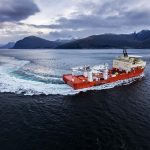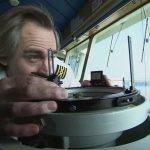When Mitsubishi came out with their Air Lubrication System, it was just one of the several energy saving techniques for ships. The Mitsubishi Air Lubrication System (MALS) was the first system of its kind which promised energy saving and emission reduction from ships using the innovative technology of Air Lubrication.
However, the shipping industry soon realized the potential of the technology, and soon, big players such as NYK Group of Companies and Damen Shipyards Group introduced their own research and experiments on the same.
According to DNV, one of the world’s leading classification societies, Air Bubble Lubrication System is one of the promising technologies which will help ships to improve their efficiency and reduce energy losses.
What is Air Lubrication System for Ships?
Air Lubrication System is a method to reduce the resistance between the ship’s hull and seawater using air bubbles. The air bubble distribution across the hull surface reduces the resistance working on the ship’s hull, creating energy-saving effects. With the right ship hull design, the air lubrication system is expected to achieve up to 10-15% reduction of CO2 emissions, along with significant savings of fuel.
How does Air Lubrication System works?
The Air Lubrication System works on the simple principle of trapping a layer of air bubbles beneath the ship’s hull. An air blower or a dedicated system is used to generate air bubbles to pass them continuously beneath the ship’s surface. Air bubble outlets are created at different locations along the bottom of the hull, symmetrically on both the sides of the ship’s center line.
The air is blown at a constant rate to form a layer of bubbles, which reduces the drag and resistance between the ship and the seawater.

The system to continuously replenish the lost air bubbles ensures that a uniform layer of air bubbles is maintained beneath the ship and the desired effect is produced.
Concerns about Air Lubrication System
Though a promising technology, the Air Lubrication System has a few concerns regarding its implementation and performance on ships. Some of the main ones are:
· The Air Lubrication System (ALS) until now can only be used for certain types of ships having flat bottoms. Ships having V-shaped hulls, such as certain warships or recreational vessels might not be able to reap the benefits of the air lubrication system.
· To trap the layer of bubbles beneath the ship’s hull is a challenging task. Though solution such as protruding ridges at the edges of the hull can help in trapping the blanket of bubbles, the sucking effect of propeller on the bubbles is difficult to defy. Another solution is to design the ship’s stern or hull in such a way that it traps the air bubbles beneath the hull. However, this would substantially increase the building cost of the ship.
· It is also feared that the air cavities made for trapping the air bubbles would affect the handling and stability of the ship at the sea. If true this can cause difficulty to the ship and the crew especially in rough seas.
· The air bubbles leaving the hull surface flow into the ship’s propeller. This can influence the efficiency, noise, and vibration of the propeller. Though according to the experiments conducted by Mitsubishi there were negligible effects of air bubbles on the propeller, rough seas and changes in fluid density can produce unfavorable results.
· In order to obtain the desired effect, it is important that air bubbles are of uniform size and are evenly distributed beneath the hull surface. Moreover, a change in air bubble diameter would drastically affect the air bubble distribution beneath the hull. An arrangement is therefore necessary to ensure that the bubbles are of the same diameter (if possible) and are well distributed beneath the ship’s hull.

As far as the MALS is concerned, the company claims that along with a high-efficiency ship hull, a container ship fitted with their air lubrication system can offer reduction in CO2 emission of up to 35% as compared with conventional container ships. Recent findings has also supported the claim that substantial fuel savings and reduction in carbon emissions is possible through Air lubrication system when combined with other promising green ship technologies.
Air Lubrication System is now a technology which is well proved to provide benefits such as reduced carbon emissions and substantial fuel savings. With rising fuel prices and increasing pressure to make ships greener, shipping companies are now implementing promising technologies that would help them reduce carbon emissions and improve ship inefficiency. According to reports, companies such as AIDA Cruise ships along with few other shipping companies have already confirmed of plans to implement Air Lubrication Systems on their ships.


